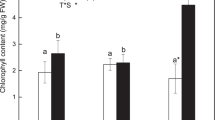Abstract
Effects of high night temperature on the lipid and protein compositions in the tonoplasts isolated from the leaves of two Crassulacean acid metabolism (CAM) plants, Ananas comosus (pineapple) and Kalanchoë pinnata were studied. The results showed that the phospholipids/protein ratios in the tonoplasts isolated from pineapple and K. pinnata leaves decreased from 1.82 to 1.21 and 2.63 to 1.50, respectively, as the night temperature increased from 20 to 37 °C. Under high night temperature, relative amount of total unsaturated fatty acids in K. pinnata was increased by 6 %, which was mainly caused by increased C18:2 and C18:3, whereas unsaturated fatty acids, C18:2 and C18:3 in pineapple did not show significant change. The distribution patterns of tonoplast proteins in the two CAM species were different between normal and high night temperature and in K. pinnata, especially those with molecular mass ranging from 66.2 to 97.4 KDa. Compared with normal night temperature, more proteins were found in pineapple, but no difference was found in K. pinnata. Thus, above result indicated that the pineapple tonoplasts could keep higher rigidity under high night temperatures compared to the K. pinnata.
Similar content being viewed by others
Abbreviations
- ATPase:
-
adenosinetriphosphatase
- CAM:
-
Crassulacean acid metabolism
- 2-DE:
-
two-dimensional gel electrophoresis
- PPase:
-
inorganic pyrophosphatase
- PEPC:
-
phosphoenolpyruvate carboxylase
- PAR:
-
photosynthetically active radiation
References
Behzadipour, M., Ratajczak, R., Faist, K., Pawlitschek, P., Tremolieres, A., Kluge, M.: Phenotypic adaptation of tonoplast fluidity to growth temperature in the CAM plant Kalanchoë daigremontiana Ham. et Per. is accompanied by changes in the membrane phospholipid and protein composition.-J. Membr. Biol. 166: 61–70, 1998.
Bligh, E.G., Dyer, W.J.: A rapid method of lipid extraction and purification.-Can. J. Biochem. Physiol. 37: 911–917, 1959.
Bradford, M.M.: A rapid and sensitive methods for the quantitation of microgram quantities of protein utilizing the principle of protein dye binding.-Anal. Biochem. 72: 248–254, 1979.
Carter, C., Pan, S., Zouhar, J., Avila, E.L., Girke, T., Raikhel, N.V.: The vegetative vacuole proteome of Arabidopsis thaliana reveals predicted and unexpected proteins.-Plant Cell 16: 3285–3303, 2004.
Chen, L.S., Nose, A.: Characteristics of adenosinetriphosphatase and inorganic pyrophosphatase in tonoplast isolated from thee CAM species, Ananas comosus, Kalanchoë pinnata and K. daigremontiana.-Plant Prod. Sci. 3: 24–31, 2000.
Kliemchen, A., Schomburg, M., Galla, H.J., Lüttge, U., Kluge, M.: Phenotypic changes in the fluidity of the tonoplast membrane of Crassulacean-acid-metabolism plants in response to temperature and salinity stress.-Planta 189: 403–409, 1993.
Kluge, M., Klienchen, A., Galla, H.J.: Temperature effects on crassulacean acid metabolism, EPR spectroscopic studies on the thermotropic phase behavior of the tonoplast membrane in Kalanchoë daigremontiana.-Bot. Acta 104: 355–360, 1991.
Kluge, M., Schomburg, M.: The tonoplast as a target of temperature effects in Crassulacean acid metabolism.-In: Winter, K., Smith, J.A.C. (ed.): Crassulacean Acid Metabolism. Pp. 389–426. Springer-Verlag, Berlin 1996.
Lin, Q., Abe, S., Nose, A., Sunami, A., Kawamitsu, Y.: Effects of high night temperature on Crassulacean acid metabolism (CAM) photosynthesis of Kalanchoë pinnata and Ananas comosus.-Plant Prod. Sci. 9: 10–19, 2006.
Lüttge, U., Smith, J.A.C.: Mechanism of passive malate efflux from vacuole of the CAM plant Kalanchoë daigremontiana.-J. Membr. Biol. 81: 149–158, 1984.
Parola, A.H.: Membrane lipid-protein interaction.-In: Shinitzky, M. (ed.): Biomembranes Physical Aspects. Pp. 159–277. VCH, Weinheim 1993.
Smith, J.A.C., Ingram, J., Tsiantis, M.S., Barkla, B.J.: Transport across the vacuole membrane in CAM plants.-In: Winter, K., Smith, J.A.C. (ed.): Crassulacean Acid Metabolism. Pp. 389–426. Springer-Verlag, Berlin 1996.
Steponkus, P.L.: Responses to extreme temperature. Cellular and sub-cellular base.-In: Lange, O.L., Nobel, P.S., Osmond, C.B., Ziegler, H. (ed.): Encyclopedia of Plant Physiology, New Series. Vol. 12: Physiological Plant Ecology I. Pp. 372–393. Springer-Verlag, Berlin-Heidelberg-New York 1981.
Wilkins, M.B.: The circadian rhythm of carbon-dioxide metabolism in Bryophyllum, the mechanism of phase-shift induction by thermal stimuli.-Planta 157: 471–480, 1983.
Author information
Authors and Affiliations
Corresponding author
Rights and permissions
About this article
Cite this article
Lin, Q., Wang, Y.M., Nose, A. et al. Effects of high night temperature on lipid and protein compositions in tonoplasts isolated from Ananas comosus and Kalanchoë pinnata leaves. Biol Plant 52, 59–65 (2008). https://doi.org/10.1007/s10535-008-0008-5
Received:
Accepted:
Issue Date:
DOI: https://doi.org/10.1007/s10535-008-0008-5




